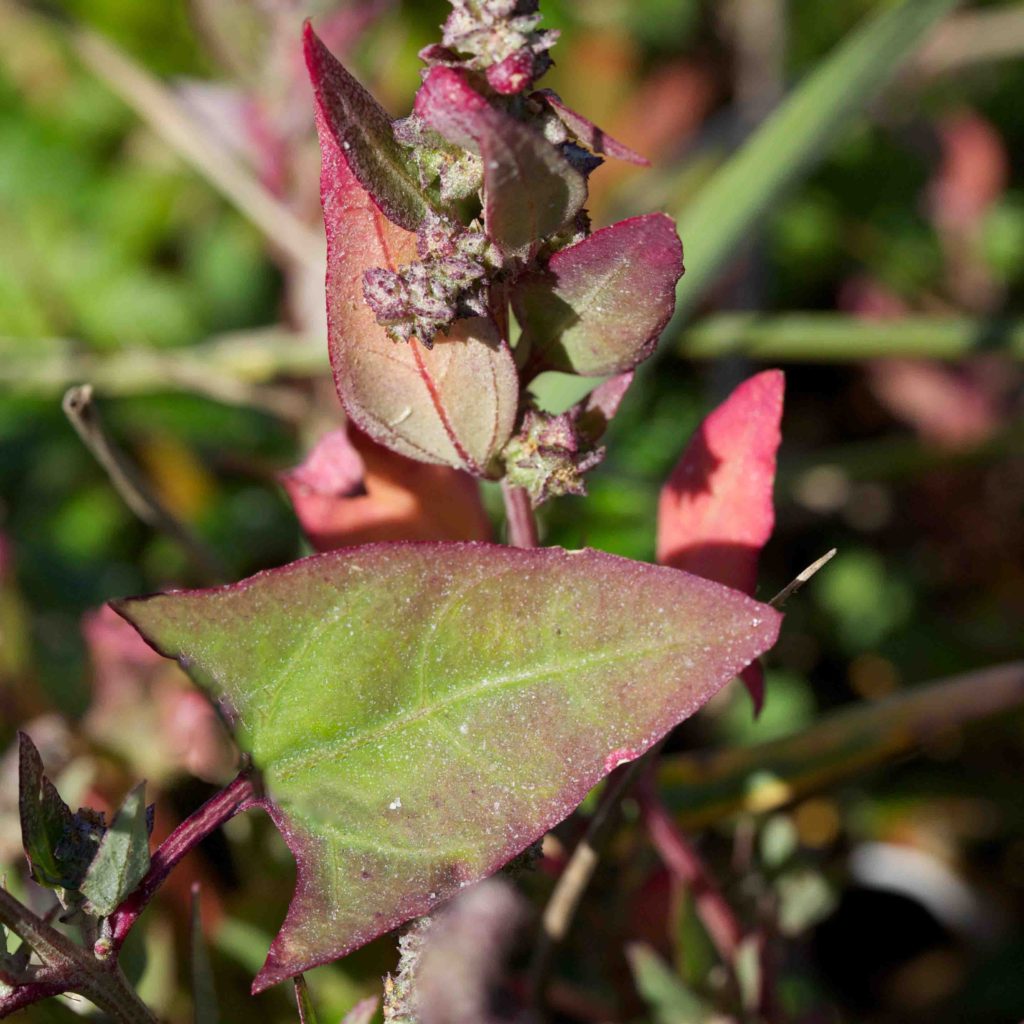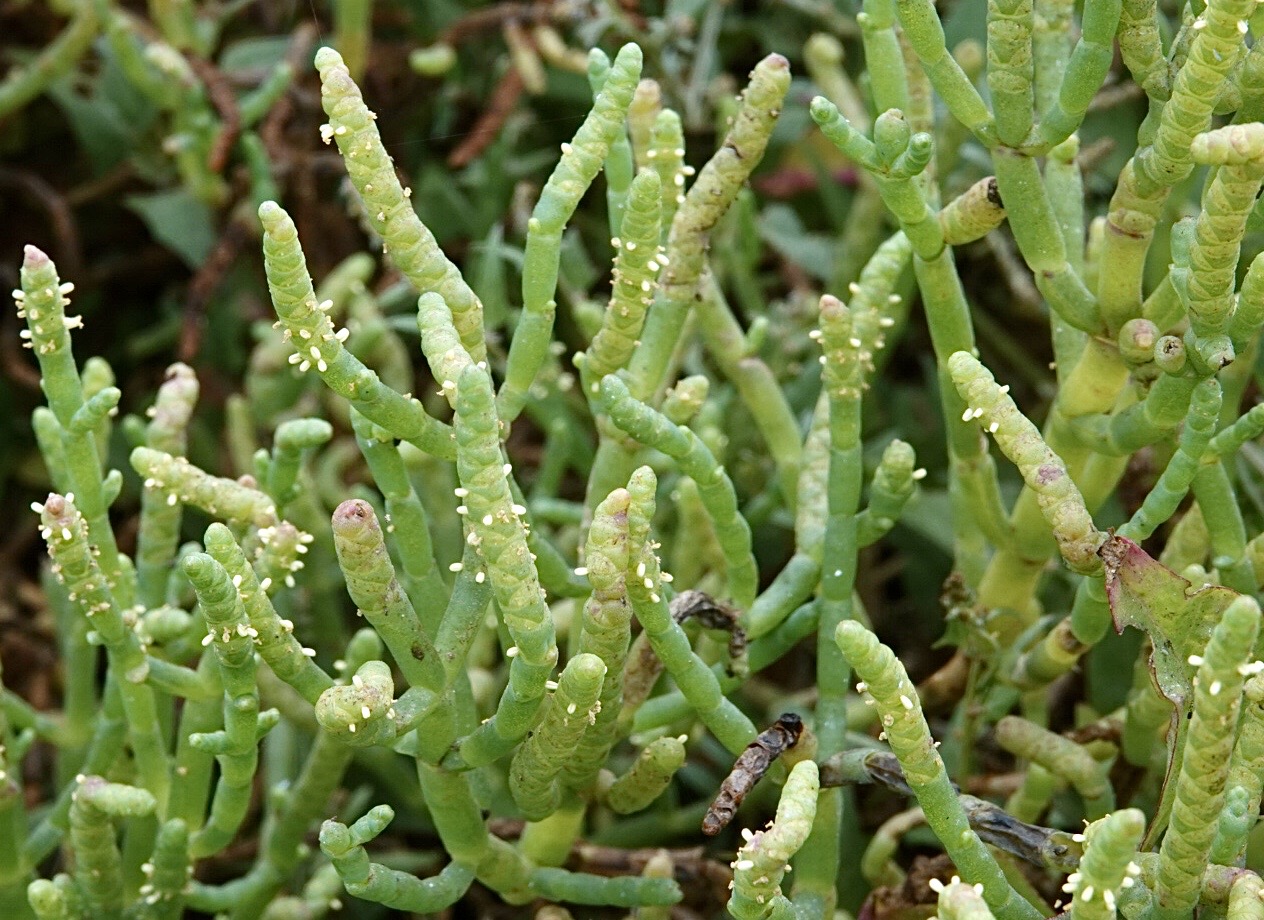Chenopodiaceae: Goosefoot Family — Saltbush & miscellaneous
The Goosefoot family will not win any beauty prizes. The flowers are in small globular clumps, having no petals but with 5 sepals. Leaves are simple, sometimes fleshy or reduced to scales. Some plants in this family are cultivated for human food, for example Lamb’s Quarters and Quinoa. Chard, Spinach and Beets are in the closely-related Amaranthaceae family.
Big Saltbush – Atriplex lentiformis
Blooms:
July–Oct
Plant Height:
0.8–4 m
Flower Size:
Medium clusters
Origin:
Native
Habitat:
Alkaline places
Notes:
A largish shrub, generally wider than tall, with smooth, not striated stems. The twigs are sometimes spine-like with age. Leaves are ovate to deltate, and scurfy (covered with small, bran-like scales), entire or wavy-edged. Fruit bracts are 2–6 mm long, and fused to their middle.
Beach Saltbush / Sea Scale – Atriplex leucophylla
Blooms:
Apr–Oct
Plant Height:
Stem up to 1 m
Flower Size:
Small
Origin:
Native
Habitat:
Coastal strand
Notes:
A prostrate and sprawling plant, generally growing near the high tide line. Leaves are pale olive-green and often covered in salt crystals. Monoecious, the male flowers occur in small, slightly elongated yellowish round clusters not surrounded by bracts. Female flowers are more or less spheric and surrounded by small, spongy bracts. The right hand photo shows the female flower, the photo to its left shows both male and female.
Fat Hen – Atriplex prostrata
Blooms:
Apr–Oct
Plant Height:
10–120 cm
Flower Size:
Medium cluster
Origin:
Europe
Habitat:
Saline places near coast
Notes:
Common, but variable in appearance. Despite its scientific name, it is often erect. Its leaves are distinctive: they are 1–9 cm long, triangular-hastate, pure green when young, but developing a strong reddish tinge with age. Flowers and fruits are borne in small terminal and axillary clusters. Photo #1 by CJH.
Australian Saltbush – Atriplex semibaccata
Blooms:
Apr–Dec
Plant Height:
up to 35 cm
Flower Size:
Small cluster
Origin:
Australia
Habitat:
Disturbed areas, scrub and woodland
Notes:
This invasive plant has several stems, 30-200 cm long, spreading mat-like on the ground. Its leaves are silvery-gray, oblong to narrowly elliptic, entire to wavy-toothed, and often scaly. Female flowers occur at the base of leaves or branches, and male flowers are in spikes at stem tips. Each flower is subtended by two bracts, ovate to almost diamond-shaped, fleshy and reddish. Fruits are dull red. Photos by CJH.
California Saltbush – Extriplex californica
Blooms:
Apr–Oct
Plant Height:
Stems up to 3 m
Flower Size:
Medium cluster
Origin:
Native
Habitat:
Sandy places, coastal
Notes:
Extriplex is a close relative of Atriplex. It is distinguished by the number of calyx lobes (3–5 rather than 4), and by having 2 kinds of seeds rather than just one. This plant is spreading to decumbent, sometimes prostrate. Its leaves are gray-green to creamy, lanceolate to elliptic, scaly, and crowded on the stems. Like Beach Saltbush (Atriplex leucophylla, see above), it is monoecious; the male flowers with a color similar to the leaves, and crowded in long clusters near the tips of the branches.
Pickleweed – Salicornia pacifica
Blooms:
July–Nov
Plant Height:
10–70 cm
Flower Size:
Very small
Origin:
Native
Habitat:
Alkaline flats, salt marshes
Notes:
This is found in profusion in salt marshes, and often turns reddish in the autumn. It is halophytic, i.e. it can tolerate high levels of salinity. It is a decumbent, perennial subshrub, with erect, fleshy, jointed branches, joints being 5–20 mm long. The tiny yellow flowers (just visible in the photos) comprise 3 fleshy tepals, 1–2 stamens and 2 stigmas. Photo #2 by CJH.
Russian Thistle / Tumbleweed – Salsola tragus
Blooms:
July–Oct
Plant Height:
up to 1.5 m
Flower Size:
Small
Origin:
Eurasia
Invasive?
Yes – limited
Habitat:
Disturbed areas, roadsides
Notes:
Stems are green to red, intricately branched, erect and curving. In maturity, it forms a round, brambly clump, that can break off at the base to form a tumbleweed. This can spread the seeds as it rolls in the wind. Leaves are very narrow with a broader base, stiff and spine-tipped. The flowers have no petals. Its sepals are surrounded by disk-like bracts, wide-winged and whitish to bright pink.



























